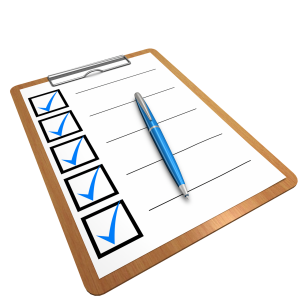Documentation:Open UBC/Guide/Open Education Self-Publishing Guide/Review your Open Textbook
What is a Peer Review?
Inviting a colleague to contribute by writing a section or chapter to your textbook on a subject for which they are the expert is one way to ensure quality information in your open textbook. Another is to ask colleagues to serve as subject-matter experts (SME) and conduct a peer review— literally a review by a peer — of your work before it goes to copy editing. (Consider using one of your Contributing Authors.)
Like other textbook tasks, providing your SME with clear expectations will make this phase of the writing project smoother. It will also save your SME time and you frustration. Here are some suggestions.
- Only give the SME text that needs their input, not the whole textbook (unless it helps with the assessment).
- Identify the course level and subject matter for which the textbook is intended.
- Use a rubric that informs the SME about required feedback. (See the BCcampus Open Education Review Rubric posted below for ideas.)
- Clarify that you are seeking the SME’s expertise on the content, but do not need help with grammar, spelling, layout, or other aspects of the textbook.
- Give the SME adequate time to conduct the review and set a deadline.
Use the following questions to help steer feedback and make sure all areas are covered.
|
Here is the BCcampus Open Education Review Rubric: |
Working with a Copy Editor(s)
Copy editors add an important element to the creation or revision of a textbook. When they copy edit, these individuals provide an objective set of eyes that ensures grammar and spelling are correct, the established style for a textbook is followed (see Appendix 2: Style Guide), and the book’s language is suitable and understandable to the readers. Skipping this stage lowers the quality of the textbook.
It is recommended that trained copy editors be used for this phase. An author should never copy edit their own work. BCcampus Open Education used both independent copy editors and editors from an author’s university or college. It was interesting to observe how the copy editors’ work influenced textbook writing and production. For example, because a copy editor is not the subject-matter expert, they read a textbook like a student might, and quickly notice when information is missing or concepts are unclear. However, unlike a student, a copy editor has the skill to help an author rewrite a passage. Authors were happy to receive this feedback because they learned to present their material more effectively.
Peer Review Process
Having a "Fixer"
During production, it’s a good idea to have — in addition to a copy editor — someone who oversees the layout, formatting, and correct treatment of the various elements of your book.
This is your fixer.
At BCcampus, we found a good fixer to be invaluable. Through experience, we learned they should be an individual with a keen eye for detail, have the ability to accurately match the exceptions noted on the style sheet against the textbook, be willing to review each chapter and section of your book repeatedly, and be able to distinguish between errors they should correct as part of their job and problems that require input from the author or project lead.
A fixer can also help add elements to the textbook, such as learning-objective textboxes and attribution statements.
Lastly, you and your fixer will learn as you go. The fixer will be spending a lot of time with the textbook, and because of this, they can offer many helpful suggestions about what’s working, what isn’t, and where the problems are.
Find help
As you list how and who will pay for your textbook (see Who Pays For This), include your support — or publishing — team. At your home institution, look for support from:
- Instructional designers (for design and layout)
- Graphic designers or illustrators (for images)
- Librarians (for copyright and licence information, and help evaluating resources and repositories)
- Technical support (assistance with authoring platforms, videos, and audio files)
- Student assistants (for gathering external resources and working as fixers). (See Fix as You Go.)
Outside of your post-secondary institution, look to:
- Colleagues at other institutions
- Your professional organization
- Open-textbook and OER communities
As the OER movement advances, several groups have come forward to support the efforts of open textbook authors and self-publishers. Below are some to consider.
|
Fixer tasks
Before they begin, create a detailed job description for the fixer or fixers so it’s clear what’s expected. Keep a running “fix list” to record both anticipated and discovered errors and inconsistencies, and note details regarding each correction, including what was fixed, the date completed, and who did the job (if there is more one person involved).
The fixer does not copy edit. However, if the fixer notices problems with the language — such as grammar, unclear text, repetitive phrases — they can report these to the copy editor or author.
Typical fixer tasks might include:
- Auditing external resources (images, videos, audio clips) to ensure they meet licensing requirements
- Ensuring that all images, videos, and other external resources added are correctly attributed. The fixer can also be assigned to adding attribution statements. (See Resources: Captions and Attributions.)
- Making sure that figures and tables are correctly captioned, numbered, and referenced in the text
- Comparing key terms highlighted in the textbook against the glossary
- Confirming that links works
- Reviewing the citation style of in-text references or footnotes and the reference list
- Checking the heading styles are correct
- Depending on the country in which a textbook is published, the fixer might be instructed to:
- change measurements (e.g., from imperial to metric)
- ensure Canadian spelling is used. (See Appendix 3: Canadian Spelling and Word List.)
Make a plan
Like is done for other parts of your textbook’s timeline, it is important to clearly spell out the expectations for and schedule of the copy editor before this work begins. While the copy editor brings essential expertise to the writing process, it is the author-publisher’s or project coordinator’s responsibility to guide that expertise. (See Project Timeline.)
Here are some items that should be addressed.
- Determine who will be the copy editor’s key contact. If someone other than the author-publisher is coordinating the project, then allow the copy editor to communicate with this individual.
- Clarify which style guide and other editing/styling references will be used by the copy editor. Instruct that a style sheet should be created and maintained; review the details of this document with the copy editor. (See Create a Style Sheet and Appendix 2: Style Guide.)
- If an authoring platform or software is being used, allow the copy editor to make grammatical, spelling, and styling changes directly in the system to save time. Trust the copy editor’s authority in this area. If the copy editor notices problems with styling that are difficult to fix, or repeat throughout the book, assign the correction to someone other than the author, such as the fixer. (See Fix as You Go.)
- If the copy editor is new to the technology being used, provide training. (See Technology: Accounts and Training.)
- Develop a copy-editing schedule. At BCcampus, we learned that copy editing chapters as they are completed is most effective. This tactic saves time for both the author and production team because problems are identified and corrected early.
- Define the copy editor’s role. For example, you might require that the copy editor check all grammar and spelling, in addition to scanning text for overall consistency, clarity, and style. If assessing content for accuracy and integrity will be the responsibility of the subject-matter expert, inform the copy editor. Include these points in the copy editor’s contract. (See Peer Review and Appendix 4: Contracts.)
- Determine which sections and elements of the textbook should be copy edited. Careful copy editing is time consuming (and potentially expensive) so if there are items that will be reviewed by other parties, tell your copy editor. Consider assigning the following to one of your support team members:
- in-text citations and the accompanying reference list
- figure and table captions
- non-Canadian spellings often cannot be corrected in text that is part of an image, graph, chart, or other figure taken from an external resource. Therefore, if spelling is important, use Canadian repositories when possible.
- figure and table numbering (are they in sequential order, consistent, and complete?)
- attribution statements (are they present for all resources? Is the format correct?)
- check links and fix those that are dead or open on the wrong web page
- archived web pages found in the Internet Archive: Wayback Machine [New Tab]can be used for dead links
- If the textbook is an adaptation of an existing book, decide if the unchanged original text and other elements of the book should be copy edited in addition to the new/changed text by the adapting author. This might be done:
- even if the original text has been copy edited to ensure that the new/changed text is consistent with the adapted work
- if the original text was not copy edited or poorly copy edited
- Ask the copy editor to keep a list of items that should be reviewed by the author such as:
- text that requires a significant rewrite
- subject-related questions
" Authors should not make changes to textbook chapters once they have been copy edited as this can undo the copy editor’s work." |
Proof Read and Final Check
How to Proofread
While the basic rules of copy editing apply whether working on a traditional or open textbook, there are some differences. The below guidelines are for (and reviewed by) professional copy editors.
- Writing and editing a web-based textbook will likely occur in an online platform such as Pressbooks. Therefore, it’s important that editors, authors, and other participating parties agree to and understand how changes in the textbook and platform will be made.
- Using an annotation tool such as hypothes.is [New Tab] can be helpful when the copy editor wants to highlight and comment on problems that should not or cannot be changed without instruction.
- Like print books, starting with a standard style guide is important. As the project progresses, be sure to record styling exceptions for the textbook on a style sheet. You might find that an openly-licensed textbook has special requirements such as ensuring that all images are properly licensed and correctly attributed. (See Appendix 2: Style Guide.)
- Be sure that the copy editor is familiar with or receives training for editing web-based textbooks in the online platform.
- A web-based textbook will likely include live links (in the body and possibly in the reference list), and multimedia. Decide at the outset of your textbook project what the copy editor is responsible for checking.
- A web-based textbook, online platform, and other technical elements introduce additional challenges. Clarify at the beginning of an editing project:
- if the copy editor should report technical problems in the textbook
- to whom the copy editor should report technical problems relating to accessing or using the online platform or textbook
- who is responsible for fixing technical problems (the author, the project manager, or the managing editor)
- Clarify, at the beginning of an editing project, who will receive the copy editor’s editing notes and how issues will be addressed. Determine if the copy editor will contact the author directly or through an intermediary, such as a project manager.
Final Check
While the basic rules of copy editing apply whether working on a traditional or open textbook, there are some differences. The below guidelines are for (and reviewed by) professional copy editors.
- Writing and editing a web-based textbook will likely occur in an online platform such as Pressbooks. Therefore, it’s important that editors, authors, and other participating parties agree to and understand how changes in the textbook and platform will be made.
- Using an annotation tool such as hypothes.is [New Tab] can be helpful when the copy editor wants to highlight and comment on problems that should not or cannot be changed without instruction.
- Like print books, starting with a standard style guide is important. As the project progresses, be sure to record styling exceptions for the textbook on a style sheet. You might find that an openly-licensed textbook has special requirements such as ensuring that all images are properly licensed and correctly attributed. (See Appendix 2: Style Guide.)
- Be sure that the copy editor is familiar with or receives training for editing web-based textbooks in the online platform.
- A web-based textbook will likely include live links (in the body and possibly in the reference list), and multimedia. Decide at the outset of your textbook project what the copy editor is responsible for checking.
- A web-based textbook, online platform, and other technical elements introduce additional challenges. Clarify at the beginning of an editing project:
- if the copy editor should report technical problems in the textbook
- to whom the copy editor should report technical problems relating to accessing or using the online platform or textbook
- who is responsible for fixing technical problems (the author, the project manager, or the managing editor)
- Clarify, at the beginning of an editing project, who will receive the copy editor’s editing notes and how issues will be addressed. Determine if the copy editor will contact the author directly or through an intermediary, such as a project manager.
" Bottom line: Checking some of your work is better than checking none of your work." |
Maintenance
Inviting a Feedback from your readers
Invite feedback from your readers
Give your readers a way to offer feedback about your textbook. Some authors do this by adding a line to the preface or introduction that invites suggestions. You can provide your contact information such as an email or create a feedback page can be added to the front or back section of the textbook. This feedback page should contain details about the kind of feedback you’re looking for and how the reader can submit comments.
If the textbook is housed in an online platform that doesn’t use page numbers, it can be difficult for readers to clearly describe what section of the text they want to comment on. In your call for feedback, encourage readers to be as specific as possible in their description of the location of their comments. Alternatively, some online platforms have a comments feature that can be enabled. Another option would be to use an external (and open source) annotation system, such as Hypothes.is [New Tab], which allows users to leave comments directly on a web page.
Think about how you will process feedback. The treatment for each item will depend on what has been reported: an error, new information, a potential resource to add, or suggestion on the structure of the textbook. It is also good practice to respond to recommendations by thanking your colleague for taking the time to write to you. If you have information about how to use your textbook or ideas about supplementary materials, include these in your response.
Another way to collect feedback on your textbook is to give instructors the opportunity to submit a review of your textbook. (See Textbook Reviews.)
Errors
Regardless of how carefully a book is copy edited and proofread, it will probably contain errors after publication. Your job is to accept this fact, create a system that allows readers to report errors to you, and develop a means to correct these errors. BCcampus Open Education uses a Report a Textbook Error form [New Tab]. A feedback form that invites error reporting might be sufficient for you, or you can just provide an email where people can contact you.
Think about who will make the corrections. This can be you or someone else, like a student assistant or copy editor. This will often depend on who has access to the book’s source files after publication. (See Remove Platform Access.) Also, how often will corrections be made? Will you fix them immediately? Monthly? Quarterly? And how will you respond to the individual reporting the mistake? A simple thank you with a description of how and when the error will be addressed is one way.
Develop a means to track and record corrected errors for your readers’ reference. You can use an erratum — a record of errors and their corrections for a book or other publication — that is added to your book. Or, like BCcampus, record adjustments on a Versioning History page. If there is more than one format or file type for which the textbook is available, remember to update these and note the date on the erratum or Versioning History page.
Revisions
Many authors are already thinking about the next edition of their textbook before the first edition is published. They realize that their textbook is a snapshot of information and that this information will continue to evolve after the book is published, so they plan for the next edition immediately. (Remember: Writing a book will never feel finished. There is always something that can be changed, improved, or added. At some point you will need to stop and say “good enough.”)
Some authors prepare by collecting notes about what they’d like to change, and material and resources they want to add to the next edition. Others create a duplicate copy of their book — easy to do in Pressbooks, for example — and use it as a template for the next edition. If you want to plan ahead for the next edition, decide how much new and changed information warrants a new edition, and how often this might occur.
Schedule
The maintenance schedule for your book can and should include all tasks that will keep your book relevant and current. Develop a timetable and process for each of the following:
- Responding to, reviewing, and incorporating feedback
- Checking and fixing links and embedded multimedia in online books
- Correcting reported/detected errors
- Adding minor updates to keep the content current
- Creating a new edition
Don’t forget to inform colleagues and collections that use and host your textbook about significant changes. (See Communications and Track Adoptions.)



